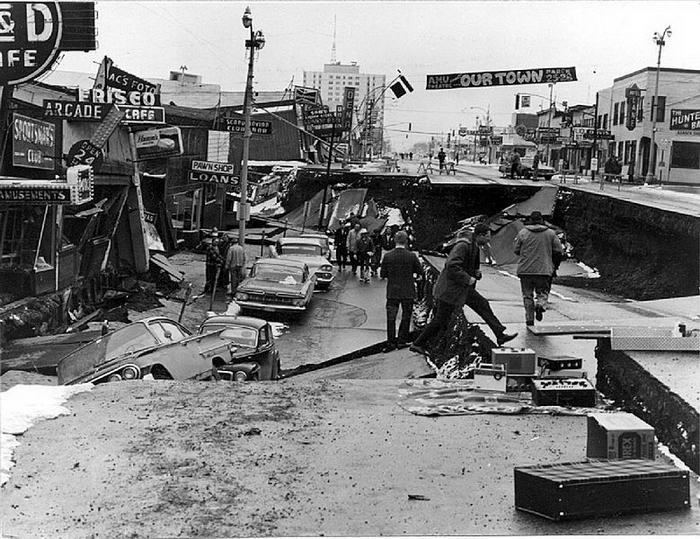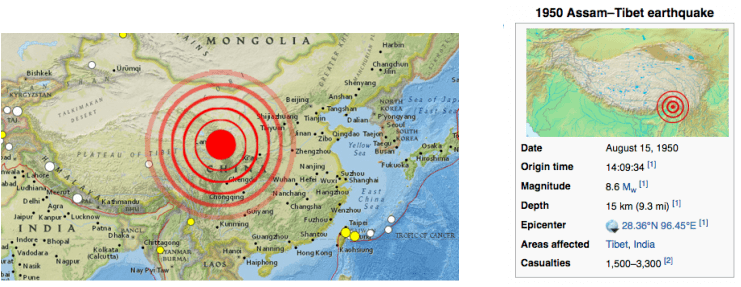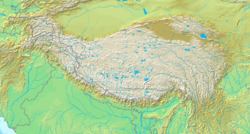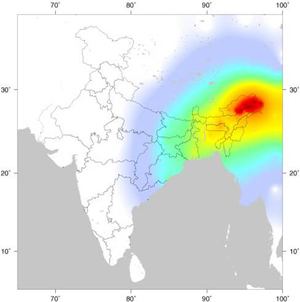Origin time 14:09:34 Depth 15 km (9.3 mi) Date 15 August 1950 | Magnitude 8.6 Mw Type Strike-slip Max. intensity XI (Extreme) Number of casualties 30,000 | |
 | ||
Similar 1897 Assam earthquake, 1934 Nepal–Bihar earthquake, 2008 Damxung earthquake, 1906 Ecuador–Colombia earthquake, 2014 Kangding earthquake | ||
The 1950 Assam–Tibet earthquake, also known as the Assam earthquake, occurred on 15 August and had a moment magnitude of 8.6. The epicentre was located near Rima, Tibet. The earthquake was destructive in both Assam and Tibet, and between 1,500 and 3,300 people were killed.
Contents

It was the sixth largest earthquake of the 20th century. It is also the largest known earthquake to have not been caused by an oceanic subduction. Instead, this quake was caused by two continental plates colliding.

Geology

In an attempt to further uncover the seismic history of Northeast India, field studies were conducted by scientists with the National Geophysical Research Institute and Institute of Physics, Bhubaneswar. The study discovered signs of soil liquefaction including sills and sand volcanoes inside of at least twelve trenches in alluvial fans and on the Burhi Dihing River Valley that were formed by past seismic activity. Radiocarbon dating identified the deposits at roughly 500 years old, which would correspond with a recorded earthquake in 1548.
Background
Strictly this was not an Indian earthquake; the epicenter was near Rima, in Tibet. Rima is situated within modern-day Zayü County. This shock was more damaging in Assam, in terms of property loss, than the earthquake of 1897. To the effects of shaking were added those of flood; the rivers rose high after the earthquake, bringing down sand, mud, trees, and all kinds of debris. Pilots flying over the meizoseismal area reported great changes in topography; this was largely due to enormous slides, some of which were photographed. The only available on-the-spot account is that of F. Kingdon-Ward, a botanical explorer who was at Rima. However, he had little opportunity for observations; he confirms violent shaking at Rima, extensive slides, and the rise of the streams, but his attention was perforce directed to the difficulties of getting out and back to India. A new account of the earthquake is now available in "Once I Was Young" a book by Helen Myers Morse (Terre-Haute, Indiana, 2003, page 167-171), She was living near Putao (North Myanmar) at the time and wrote letters home. She - and 3 other American missionaries in different villages - speaks of the main shake, and the numerous aftershocks, as well as of the noise coming out of the earth.

Aftershocks were numerous; many of them were of magnitude 6 and over and well enough recorded at distant stations for reasonably good epicentre location. From such data Dr. Tandon, of the Indian seismological service, established an enormous geographical spread of this activity, from about 90 deg to 97 deg east longitude, with the epicentre of the great earthquake near the eastern margin.

One of the more westerly aftershocks, a few days later, was felt more extensively in Assam than the main shock; this led certain journalists to the absurd conclusion that the later shock was 'bigger' and must be the greatest earthquake of all time. This is a typical example of the confusion between the essential concepts of magnitude and intensity. The extraordinary sounds heard by Kingdon-Ward and many others at the times of the main earthquake have been specially investigated. Seiches were observed as far away as Norway and England. (p. 63-64.)
This great earthquake, destructive in Assam and Tibet, has a calculated magnitude of 8.6 and Strasbourg regards it as the most important since the introduction of seismological observing stations. Alterations of relief were brought about by many rock falls in the Mishmi Hills and destruction of forest areas. In the Arbor Hills 70 villages were destroyed with 156 casualties due to landslides. Dykes blocked the tributaries of the Brahmaputra; that in the Dibang valley broke without causing damage, but that at Subansiri opened after an interval of 8 days and the wave, 7 metres high, submerged several villages and killed 532 people.
Future threat
An article in Science, published in response to the 2001 Bhuj earthquake, calculated that 70 percent of the Himalayas could experience an extremely powerful earthquake. The prediction came from research of the historical records from the area as well as the presumption that since the 1950 Medog earthquake enough slippage has taken place for a large earthquake to occur.
